Paul Gilster's Blog, page 202
May 8, 2014
Curation of an Interstellar Booklist
As a librarian with a futuristic bent, Heath Rezabek has developed the Vessel Project as a way of studying how we can preserve our knowledge and culture against future risk. That work — and Heath’s ongoing engagement with the Long Now Foundation — asks what we might put into a long-term archive housing the essence of our community. Finding the answers involves ‘community curation,’ asking varying interest groups to develop and discuss their choices. We’re going to run such a survey with the Centauri Dreams readership, helping to firm up a shortlist of books on interstellar topics that I’ve been wanting to return to for some time. That list will appear tomorrow, but today Heath explains strategies for building archives to represent communities like the one that clusters here around interstellar flight.
by Heath Rezabek
In my first Centauri Dreams installment, I noted that I had recently begun an Internship with the Long Now foundation, assisting and advising in their initial community curation of a 3,500 volume collection called the Manual for Civilization. At that time, I promised updates on the project as it progressed, since it bears such a kinship to themes and objectives reflected in the Vessel Project. I have not yet done an update.

Image: The Interval: Long Now Foundation, San Francisco, CA.
With the site of the collection soon to open — the name of their headquarters space being The Interval — and with myself about to make a trip out to San Francisco for part of those opening activities at the end of May, now seemed like a good time to reflect upon my experience as an Intern on the Manual for Civilization. The Internship draws to a close, and I look towards the future, by considering the importance of community curation at all levels and in all kinds of communities. I will also tie these thoughts back to current and prior work on the Vessel proposal, and launch an effort towards community curation of a core reading list for Centauri Dreams readers based on Paul Gilster’s existing shortlist on interstellar research.
As a brief summary, the Long Now Foundation is a nonprofit organization whose purpose is to foster long term thinking through concrete projects which catalyze public debate and discussion about the very long term, while at the same time striving for substantial real-world goals. Its cornerstone project is the construction of a 10,000 Year Clock, “designed to run for ten millennia with minimal maintenance and interruption. The Clock is powered by mechanical energy harvested from sunlight as well as the people that visit it. The primary materials used in the Clock are marine grade 316 stainless steel, titanium and dry running ceramic ball bearings.” No completion date is set, but construction work at the first site in west Texas is in preparation.

Image: The Rosetta Disk.
Another project with concrete utility as a key for decoding 1,500 human languages is the Rosetta Disk. At the ESA’s invitation, an early copy of this disk is on the Rosetta probe.
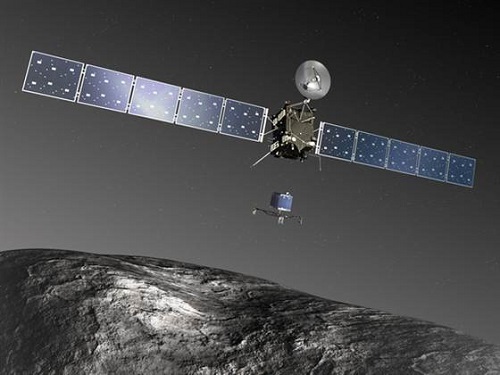
Image: The Rosetta Probe (ESA).
Over time, Long Now has undertaken numerous other concrete efforts, and the Manual for Civilization is one. This collection is to be a 3,500 volume book collection and library, housed at its new headquarters in San Francisco, The Interval. At time of launch, their plan is to have 1,000 of those volumes on the shelf, and to build the rest of the collection over time through various community-driven means. These include annual vetting of the existing collection and the chance to debate the addition or removal of items in what is proposed to be a fixed number of items.
The overarching question used to drive curation is “What books would you most want to help rebuild civilization?” To ask this question of a small subset of individuals is, obviously, to push them to think well beyond their means (much as is true of asking designers and engineers today to plan towards building an eventual interstellar starship). Yet this is a community dedicated specifically to long-term thinking, and to fostering that activity through its efforts.

Image: The 10,000 Year Clock Prototype (Power and Winder test).
One of the earliest critiques and responses to the Vessel proposal on Centauri Dreams was from a reader who could not see the point of attempting comprehensive archival of cultural content in the first place (much less other material, such as endangered biomass or scientific knowledge). The reader suggested that individuals and communities would always be undertaking archival tasks and the passing-down of their own heritage, making any kind of concerted effort unnecessary.
As a librarian, I continue to disagree; yet working on the Manual for Civilization project has reminded me that there is a spectrum of appropriate response to the need for remembrance as a mitigation of permanent stagnation or flawed realization. While the first draft of the Manual for Civilization does strive to be comprehensive, there is also significant room for interpretation and opinion in its scope. Its primary categories, at this stage, are a blend of comprehensive and community-focused topics: Cultural Canon and Mechanics of Civilization are both categories which point at widespread and general utility (once fleshed out by the addition of unfamiliar or more broadly global materials). The two other initial categories, Rigorous Science-Fiction and Long Term Thinking/Futurism, are there in part because of their direct interest to the specific community doing the curation — in this case, the Long Now Foundation.
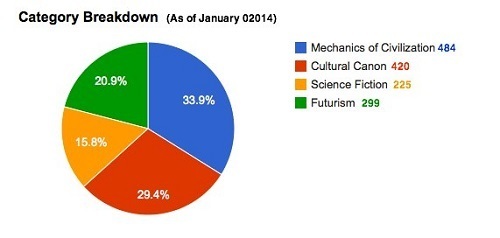
Image: Categories in the Manual for Civilization (as of January 2014)]
With the facility and its opening events now in sight, Long Now has been bringing together existing physical copies of many works on the shortlist, as well as seeking out donor copies to fill out the collection. I myself have committed several to those shelves, including two signed editions. I have been impressed by the positive response seen both in the public, as well as in myself, to the prospect of helping to build a physical reference collection meant to endure over time.
It has also convinced me that similar processes could be carried out for other communities of interest, and perhaps with different types of materials. Empowering a community to build what amounts to an extended wishlist for that collection becomes the first step in establishing and stewarding its cohesion over the long term.
One of my own contributions to the process was the proposal that we create a customized build of the allourideas.org A/B sorting platform, (which I find useful for a great many things). This was done, allowing the project to pull ISBNs and other metadata into the survey from a custom metadata entry system. The community was invited to propose titles, and begin the process of sorting the ones already in the list.
Additionally, and appropriately, the core collection was seeded with the personal shortlists of Long Now’s founding members and some community exemplars (as I call them). (See Brian Eno; Neal Stephenson; Stewart Brand; Kevin Kelly. A blending of the lists — the community curated A/B lists and the shortlists of community exemplars — was undertaken by Long Now leadership, and thus the first curation list was born.
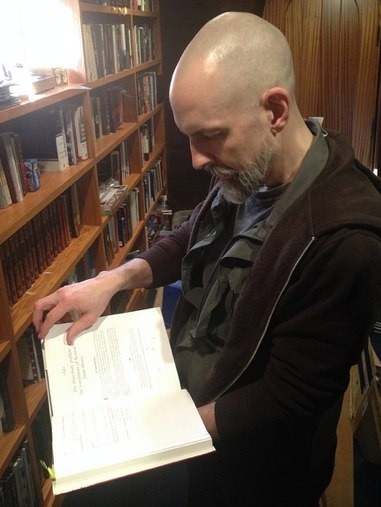
Image: Neal Stephenson selects titles for his shortlist, as a community exemplar.
During this process, we encountered a few questions regarding the diversity of the collection and its sources. The most public and illuminating of these questions came from Maria Popova, who runs an outstanding literary blog called Brainpickings. Her list and discussion was illuminating in itself, but it also helped me over a mental hurdle in understanding the purpose and point of such a process, and this has enriched my own conception of the larger long term goals of the Vessel Project.
As I wrote in my comments-response to a similar inquiry on the Long Now blog,
“I do think it’s important to remember that this particular collection is meant, initially, to serve as a core collection reflective of its hosting organization, housed at their headquarters site. While the question of what would most help rebuild or preserve a cultural core is a crucial one to ask, there might also be as many answers as there are communities of interest willing to ask it. I think that’s a good thing, actually: it reminds us that no such collection could ever be absolutely authoritative unless it were nearly exhaustive, but at its best might strive to be a reflection of its constituents’ ideals and aspirations. The wider that circle, the more comprehensive the collection — but universal representation right from the start would be nearly impossible.
The core lists being submitted by founders and community [exemplars] is only one current going in to the process. […] Every such collection is bound to differ in its details, and in those differences lie a strength. Who’s to say which resources will confer the greatest resilience or remembrance for a given community, other than that dynamic community itself? We can aspire, but more importantly, I think, is that the question “What do we feel is most worth passing on over the long term?” be asked, by as many unique communities as can.”
In articulating this, I had arrived unexpectedly at a middle-ground between the original ideal of Vessel — the seeding of numerous institution-level comprehensive collections, secured against unforeseen catastrophes in a range of ways — and the default remembrance strategy of throwing seeds to the wind, come-what-may, suggested by the critique that everyone will already save whatever matters for themselves.
The community of interest is the place where those two strategies meet.

Image: Interior visualization of The Interval.
This middle ground suggests a larger role for what I call community curation and community collections. Community may be very broadly defined, to include everything from a small family to a whole nation or colony. It seems useful to consider the possibility that larger collections might be built up of smaller collections: if each item and set of items bequeathed to a community collection is vetted for its long-term importance (however one wishes to define that), then as a whole the collection will reflect this objective even if the sets within it differ significantly.
The key element is to ensure the asking of the question. It can be phrased in different ways, complete with the differences those many ways suggest. “What would you place in a vessel containing the essence of your community?” “What is important enough to you to pass on beyond your own time?” “What best reflects the essence of your community’s knowledge and influences?” “What is most worth saving?” “What is at most risk of being lost?” And so on.
There will always be space and a place for those who answer this question simply with their lives, by saving what they value in their own collections and passing it on when they themselves pass on. However, given the complex challenges which face future generations (wherever they may make their homes), the asking of these questions and the community curation of collections which result may serve as crucial guidance in the short and medium term. Perhaps surprisingly, and perhaps controversially, we can propose that the greater the number of these communities and diversity of their resulting collections, the greater these collections’ value to communities in the future.
In other words, the idiosyncrasies seen in the Long Now Foundation’s collections, far from being a weakness, are a source of hybrid vigor and a carrier wave for the priorities this particular community will have as it evolves. A community has asked a particular question, and preserved its own unique approach to adapting as it moves into the future.

Image: Manual for Civilization (Logo).
At the end of May, I will travel to San Francisco to celebrate this Internship and to see the collection in its seedling stage. I will return with a renewed sense of direction and purpose for the Vessel Project, clear to me already in outline. Future efforts will continue to ask the question of curation to, hopefully, a range of communities. Each will answer somewhat differently, and in these differences will lie those communities’ particular traditions.
The results of these Vessel Surveys will be made openly available whenever possible; books are perhaps an increasingly controversial medium to use as a baseline, but they are also surprisingly resilient as media, and in the short term are good markers for particular ideas, priorities, and influences. Vessel Surveys which embrace other media are possible as well.
Not all will focus immediately on core materials for rebuilding civilization, but might initially focus simply on the themes and ideas integral to that community. Such would be the case with a thematic community like Centauri Dreams.
In this spirit, and with Paul’s blessing, I would like to facilitate a community curation of the Centauri Dreams readership. Initially, we will start with books; but if comments suggest that ideas or some other carrier for influence is preferable, we can launch a survey for that type. This is an experiment and a gift, from one member of the Centauri Dreams to all others, and from all of us to all who come.

Image: Centauri Dreams: Community Curation Vessel Survey (Live tomorrow).
In the fullness of time, who knows who might find these influences pivotal to their own exploration?
Tomorrow, we’ll present Paul’s initial shortlist of key books as influences, and then we will open up a Vessel Survey for suggestions of others from the community.






May 7, 2014
2030s: The Decade of Europa?
Our recent discussions of the Jovian moons Ganymede and Europa highlight a fact that not so long ago would have seemed absurd. Three of the four bright dots that Galileo saw through his primitive telescope around Jupiter are potential habitats for life. Even battered Callisto gives evidence of an internal ocean, as do, of course, both Ganymede and Europa. But why stop there? Further out, Titan is worth exploring both on the surface and under it, and tiny Enceladus may be both the easiest to study and the most bizarre astrobiological possibility we’ve yet found.
The ‘easy to study’ part comes from the fact that Enceladus conveniently spews vapor from its own internal reservoirs into space, making it possible for a space probe to analyze the contents without ever touching down on the surface. The ‘bizarre’ part comes from the fact that those fissures exist, surely a sign of Saturn’s gravitational grip upon the flexing moon, but also a reminder that these outer moons have leaped into our consciousness as liquid water-bearing places. Remember, it wasn’t that long ago that we assumed Europa itself would be just another crater-scarred, inert ball of rock and ice. The Voyager missions changed everything.
Lee Billings is sufficiently encouraged by facts like these to put Europa at the very top of his list of destinations, speculating in his new essay in Aeon Magazine that our enthusiasm for Mars may be misplaced. We’re always ‘following the water,’ knowing that water helps in the transmission of biochemical energy, nutrients and waste, not to mention its shielding effects against cosmic radiation and its ability to retain warmth. But Billings, the author of Five Billion Years of Solitude (Current, 2013) sees our current Mars efforts as ‘cautious and procedural, perhaps to a fault, as a result of past overreaches in the search for Martian life.’
Indeed, scientists who specialise in Mars have been forced to dial down their dreams, hypothesising ever-smaller windows of opportunity for past life on the red planet, and ever more inaccessible refuges for anything now living there. Native Martians, if they exist at all, are most probably microbes clinging to life almost unreachably deep beneath the surface. This does not diminish the importance of exploring our neighbouring planet, but it must be admitted that there might well be more promising places to seek alien life. Indeed, if following the water is the prime directive in the search for extraterrestrial life, it increasingly appears that we should look beyond Mars to an icy moon of Jupiter called Europa.
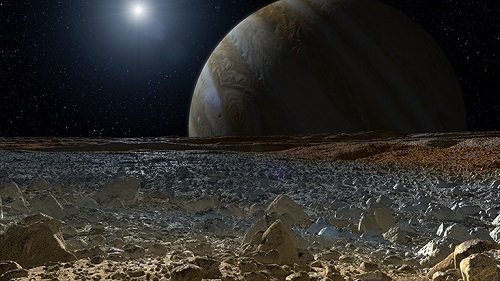
Image: This artist’s concept shows a simulated view from the surface of Jupiter’s moon Europa. Europa’s potentially rough, icy surface, tinged with reddish areas that scientists hope to learn more about, can be seen in the foreground. The giant planet Jupiter looms over the horizon. Credit: NASA/JPL-Caltech
The russet upwellings of mineral salts that mark Europa’s cracks and fissures helped us see that a warm ocean sustained by Jupiter’s tidal forces and the flexing of the interior could exist, and that that ocean could have existed for billions of years. Imagine finding evidence that life of some kind existed under that ice. The discovery would implicate the other moons I’ve mentioned, and could, as Billings reminds us, take us out as far as Pluto in the hunt for subsurface water, looking for tidal heating or radioactive decay as sources of a comfy astrobiological warmth.
Europa, of course, is a very tough nut to crack. For one thing, you’re dealing with magnetic fields around Jupiter that produce extreme radiation hazards not just for manned missions but robotic orbiters, which adds greatly to the cost of any contemplated mission. Then there’s the matter of Europa’s crust, which might be a few kilometers deep or a hundred. Here the Enceladus model may come to our rescue, for just as Enceladus vents subsurface materials into space, so too may Europa. It was just last year that the Hubble Space Telescope was used to detect water vapor here — an estimated 7000 kg of water per second — blown 200 kilometers into space.
Fly a mission through these plumes and it should be possible to learn a great deal about what’s going on by way of chemical and physical processes beneath the ice, perhaps even evidence of biological activity or, as Billings adds with a touch of whimsy, ‘you might even catch a flash-frozen fish.’ For that matter, a robotic lander near a Europan fissure might snare highly interesting results. Sure, Mars is a much easier target, but look at the sheer number of orbiters and landers both in place and planned and contrast that commitment to the less than $1 billion NASA is now targeting as the pricetag for the Europa mission it’s gathering concepts for.

Image: Reddish spots and shallow pits pepper the enigmatic ridged surface of Europa in this view combining information from images taken by NASA’s Galileo spacecraft during two different orbits around Jupiter. The spots and pits visible in this region of Europa’s northern hemisphere are each about 10 kilometers across. The dark spots are called “lenticulae,” the Latin term for freckles. Their similar sizes and spacing suggest that Europa’s icy shell may be churning away like a lava lamp, with warmer ice moving upward from the bottom of the ice shell while colder ice near the surface sinks downward. Other evidence has shown that Europa likely has a deep melted ocean under its icy shell. Ruddy ice erupting onto the surface to form the lenticulae may hold clues to the composition of the ocean and to whether it could support life. Credit: NASA/JPL/University of Arizona/University of Colorado.
Billings ends his essay with characteristic eloquence:
Even if Mars proves totally, irrevocably dead, one can still squint up at its ruddy disk in the night sky, and envision a better future for it. Someday, humans might walk there, perhaps even live. No one has such dreams for Europa. If Mars is a warped mirror we stare into, while imagining ourselves as explorers in some pleasantly familiar frontier future, then Europa must be a locked door, or maybe a matte-black monolith, cold and indifferent, an abyss that might, some day, gaze back at us, if only we could first convince ourselves to look.
I like that, especially the nod to Clarke’s monoliths, and I thought about the distance between Bradbury and Clarke as I absorbed Lee’s essay. Clarke went to Mars as well, in The Sands of Mars (1951), his first published novel, while Bradbury’s Mars was a splendid, visionary dream sequence. Both writers depicted a Mars that could be tamed by humans, but it’s the mysterious Europa of Clarke’s Space Odyssey series that draws me more.
Clarke had planned to delay 2061: Odyssey Three until the Galileo mission to Jupiter was operational, but he went ahead after that mission’s launch delay, so that when the book was published in 1987, it couldn’t have drawn on any of the Galileo findings. But even with Galileo’s imagery, Europa’s hidden depths are still enigmatic, their exciting promise hidden by their layered ice. Clarke’s Europa would be all about transformation as an ignited Jupiter (‘Lucifer’) heated up all the Jovian moons to bring life to a once desolate system.
What might come out of a thawed Europan ocean in a scenario like that? Life is all about transfiguration — it emerges out of an environment, changes and is changed by that environment — and we are left to wonder how complex it might become given the right mix of oxidized mineral salts filtering back down through the fractured Europan ice and the chemical reactions near deep water hydrothermal vents. The prospect is so compelling, the possibilities so alien to our earlier conceptions of the Galilean moons, that surely we can come up with a mission following up ESA’s Jupiter Icy Moons Explorer (JUICE) to make the 2030s the decade of Europa.






May 6, 2014
Proxima Centauri Transit Search to Begin
Anyone who follows this site is well aware of David Kipping’s work as Principal Investigator of The Hunt for Exomoons with Kepler, which sifts through the voluminous Kepler data in search of exoplanet satellites. Now based at the Harvard-Smithsonian Center for Astrophysics (CfA), David lists a number of research interests including the study and characterization of transiting exoplanets, the development of novel detection and characterization techniques, exoplanet atmospheres, Bayesian inference, population statistics and starspot modeling. Yesterday he wrote with news that will get the attention of anyone interested in stars near the Sun. A transit search of Proxima Centauri, never before attempted, is about to begin.
By David Kipping

I wanted to let Centauri Dreams readers know that I’m leading an upcoming observing campaign with MOST this month and the mission’s PI, Jaymie Matthews, recently shared with us an important decision by the Canadian Space Agency (CSA) on May 1st which discontinues funding for the MOST (Microvariability & Oscillations of STars) space telescope as of August 2014 (click here for more). As you probably know, MOST is a suitcase sized space telescope in operation since 2003 (>10 years!). Jaymie Matthews is the Principal Investigator and he is naturally disappointed and seeking alternative ways of funding MOST to keep it going for longer. To be clear, there are no hardware failures onboard which would prevent the mission from continuing for much longer.
MOST is sometimes called the “Humble Space Telescope” and there was a running joke that it was the first astronomy telescope which weighed less than its PI! In many ways, MOST is a model for small cubesats and for example the upcoming CHEOPS mission. Unlike Kepler or COROT, this telescope is functioning very well still, so many of us are very disappointed by this decision. The cost of running MOST each year is also relatively low, at just $450K per year. I believe Jaymie is looking for ways to slim that down in efforts to fund MOST privately or via a crowd-funding platform. [We’ll track this effort as it develops - expect more soon - PG].
MOST has discovered a great deal of exciting science both in terms of stellar astrophysics and exoplanet research. Perhaps its most famous discovery was the detection of transits of 55 Cancri e, the first naked eye star with a transiting planet (and I think still the only one!). This kind of high-risk high-gain science is perfect for MOST and nothing else really fills the gap right now. [You can read about MOST and 55 Cancri e in A Super-Earth in Transit (and a SETI Digression)].
Let me also tell you about a very exciting observing campaign for MOST from May 13th-May 28th which fits right into that category. In a 15-day continuous staring run, I am leading a campaign to observe Proxima Centauri in order to search for transits. This is the first transit survey of Proxima to date, as far as we are aware, which is quite extraordinary given it is the closest star.
I was inspired by the discovery of the KOI-961 system (Muirhead et al. 2012) to propose for this target. KOI-961 is a late M-dwarf in Kepler’s field with three planets discovered by Muirhead and colleagues. By Kepler’s standards it is a very rare star since M-dwarfs usually appear too faint for Kepler. As you know though, these stars are intrinsically very common in the cosmos with M-dwarfs comprising ~75% of all stars. The three planets in question found were all tiny, sub-Earth sized (0.73, 0.78 and 0.57 Earth radii) and therefore likely very low mass, roughly 1/3 Earth mass or less based on mass-radius scaling relations for terrestrial planets.
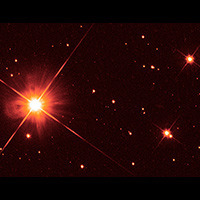
So the key point is that current radial velocity surveys would never have seen such low-mass planets; they just don’t have the sensitivity. This all makes sense from the emerging trend that smaller stars tend to host smaller planets. If RVs can’t find a KOI-961 system of planets around Proxima (which are broadly similar stars, remember), then could transits possibly succeed?
The answer is a resounding yes – because Proxima is so small yet relatively bright at V=11, transits of a system of planets like KOI-961 would cause transits depths of 2.6 to 1.4 mmag, within the grasp of MOST. By the way, an Earth-sized planet would cause a whopping 4 mmag transit! But things get even better: KOI-961 also hosts a very compact set of planets with orbital periods of 0.45, 1.21 & 1.86 days. Being so close to their star, the transit probability of such worlds is enhanced to 11.4, 5.9 and 4.5 percent respectively. That’s not bad at all! Finally, we know that the occurrence rate of planets around M-dwarfs (although not quite as small as this star) is very high, with Dressing & Charbonneau (2013) for example estimating ~1 planet per M-dwarf. On this basis, we argue our chances of success are around 10%.
Image: Proxima Centauri (Alpha Centauri C). Credit: NASA, ESA, K. Sahu and J. Anderson (STScI), H. Bond (STScI and Pennsylvania State University), M. Dominik (University of St. Andrews).
So yes, our chance of success is just 10%, a modest but respectable figure. Yet this probability should be weighed against the potential reward if we succeed. Just think about the possibilities of not only our nearest star having a planet but the unprecedented opportunities for following-up a bright, tiny M-dwarf hosting a transiting rocky planet(s). Any planet found would become everyone’s favorite overnight and JWST would be able to smell the atmosphere quite easily.
But the most compelling reason of all to look for a planet around Proxima is that such a world may provide the impetus needed to build the first interstellar space craft – we could fly there within our lifetimes and send back a photo.
If you need any more icing on the cake, a planet receiving the same insolation as the Earth around Proxima would have an orbital period of about 8.7 days and so our 15-day campaign should see a transit like that too.
Anyway – I wanted to share with you the news about MOST and the exciting observations coming up, which I think highlight the unique opportunities MOST is able to pursue.






May 5, 2014
Thoughts on Karl Schroeder’s ‘Lockstep’
We last heard from Karl Schroeder in his essay Creative Constraints and Starflight, published here back in March. Schroeder was describing his new novel Lockstep, whose ingenious plot is in the service of a daring idea: If we are limited to speeds well less than that of light, can we still find a way to achieve the kind of deep space civilization we’ve seen depicted in so much science fiction? That would include travel to far places within single human lifetimes, trade with colony worlds, and much of the panoply of what is sometimes called ‘space opera.’
Schroeder’s solution is ingenious and challenges the preconceptions most of us bring to interstellar flight, which is why I want to return to Lockstep this morning. I had read a pre-publication copy late in 2013 and found that it triggered some incipient thoughts on how we relate to time that I needed to work out. In particular, not only in Karl’s work but in Neal Stephenson’s and, to an extent, in Alastair Reynolds’, I’ve found a creative re-casting of our relationship to time and how we measure it off in terms of a single human lifetime. Exactly what is ‘subjective’ time, and is there a specific way it should relate to ‘objective’ time?
The question Schroeder forces upon us is whether time is best measured as a clock-driven passage of minutes, hours and days (I call it ‘objective’ time while acknowledging its malleability in the form of spacetime), or as an accumulation of life experiences that can be separated from this objective time. In the world of our experience, we may think of time as a substrate through which we move — we have so many years in our lives and the clock is always ticking in the background. In the world of Lockstep, that ticking can be suspended. Adjusted. The human experience of time is what it has always been, but the world around it is accelerated.
Benefits of Adjusted Chronology
We’re in a world where suspended animation is routine and about as eventful as getting into bed for a good night’s sleep. You might sleep a day, or a year, or in the case of young Toby McGonigal, the book’s protagonist, a breathtaking 14,000 years before waking up. While conventional, day to day life goes on elsewhere, the Lockstep worlds are those that have entered into a contractual arrangement to use suspended animation to stay synchronized. A 360/1 schedule, the primary one in this culture, keeps people suspended for 359 months out of every 360. It’s this last month in which they awake and get about the business of civilization.
Karl has already described this scenario in our pages and we’ve had discussions about its pluses and minuses. But let’s look back and review for a moment what a society like this gets from this strange arrangement. You can see that the so-called ‘fast worlds’ — the inner planets, for example, living as we do today without recourse to suspension — suffer from constraints that the tiny outer worlds in the far Kuiper Belt and beyond don’t endure. As Toby gets used to the world he has awakened into, he marvels at its fecundity. “We’re in the middle of nowhere between the stars but this place seems as rich as Earth. Though that can’t be.”
But of course it is, for reasons he comes to learn, just as he learns the key role his own family has played in this outcome. Schroeder describes all this in terms of computer technology. The locksteps, small worlds synchronized on their schedules with each other, form a synchronous network, with each node acting at the same time. In other words, imagine a large number of tiny, isolated worlds in the Oort Cloud, all sending out their cargo (including passenger ships) on the same schedule. Tuning the ‘frequency’ properly can turn desolate outposts into economically viable societies, for reasons Schroeder is careful to explain in a book where the consequences of this tuning are extremely well thought out and depicted with real panache.
There were tiny colonies that didn’t own even a chunk of cometary ice but harvested the impossibly thin traces of gas found between the stars using modified magnetic ramscoops. In an abyss so empty that there was only one hydrogen atom per cubic centimeter, the scoops filled their vast lungs like baleen whales filtering tenuous oceanic plankton. It could take them decades to fuel a single fusion-powered ship with enough hydrogen to visit their nearest neighbor. Yet even these little starevelings could contribute to the wealth of Lockstep 360/1, because its clock ticks were slow enough for them to keep up.
Automate your industry and go to sleep. When sufficient time has passed to allow the accumulation of a viable amount of resources, you emerge to engage in the necessary trade with other worlds like your own, worlds on the same schedule. A richer world might join a faster lockstep since it could manufacture goods at a greater clip, but even the poorest world has the chance to be part of a functioning civilization at a slow speed. Travel between the worlds takes a lot of time — remember, we’re in a world where Einstein’s speed limit still applies — but on a 360/1 schedule, you might travel half a light year while ‘wintering over,’ as Schroeder calls it.
That makes long periods of suspended animation a genuine plus for those with a yen to engage with the greatest number of the more distant worlds. A wintering over journey at a 36/1 schedule can have a certain number of destinations within range, but a 360/1 lockstep can deal with a thousand times more worlds. Doubling the distance you can travel opens up more distant worlds scattered through three-dimensional space, and a kind of empire can emerge that has resonances with everything from Doc Smith’s clanky space tales to the world of Star Trek.
Differentiation of the Culture
But back to the human experience of time, which is what fascinates me about what Schroeder is doing here. The understandable immediate reaction to a lockstep is that it simply slows the pace of discovery — how to progress when people only wake up briefly every thirty years? But the question is, progress on whose terms? For those whose lives take place within the lockstep, the framework of time outside has been abandoned. They still can expect to live their allotted lifetime, but it’s a lifetime that might take in vast stretches of time during which, to civilizations not in a lockstep, their own empires might rise and fall as the lockstep goes about its way.
All he could really sort out was that humanity and its many subspecies, creations and offspring had experienced many rises and falls over the aeons. Since they had the technology, and lots of motivations, people kept reengineering their own bodies and minds. They gave rise to godlike AIs, and these grew bored and left the galaxy, or died, or turned into uncommunicative lumps, or ran berserk in any of a hundred different ways. On many worlds humans wiped themselves out, or were wiped out by their creations. It happened with tedious regularity. The only reason there were humans at all, these days, was that there were locksteps.
I think this is fascinating — the lockstep as a backup, a repository for the entire species. Schroeder continues:
They served as literal freezers, preserving ancient human DNA and cultures. All kinds of madness might descend upon the full-speed worlds circling the galaxy’s stars — expansions, contractions, raptures, uploading, downloading, mind control, and body-swapping plagues (quite apart from the usual wars, dark ages and terraforming failures) — but everybody ignored those useless frozen micro-worlds drifting between the stars. Their infinitesimal resources and ancient cultures held no interest to the would-be gods of the inner systems. So once those would-be gods had wiped themselves out, the telltale silence from formerly buzzing stars would alert this or that lockstep, and they would send some colonists back. A few millennia later, the human population on Earth and the other lit worlds would again number in the billions or trillions, and some of those would return to the locksteps…
It’s a way of living deep into the remote future, this lockstep, and it sets up levels of civilization that work at different rates of time, from those who continue, as we do, to live one day for every day that passes, to those who adjust that schedule according to the needs of their environment, which out in the Kuiper Belt or Oort Cloud can be quite different. Freeman Dyson has often talked about the biological differentiation that will occur in our species as we adjust to varying conditions moving outward from the Sun. Schroeder is describing a chronological evolution that takes place as entire cultures become disconnected by their choice of calendars.
So how do you feel about it? Is sleeping for thirty years a waste of time? Or is a lockstep a way to continue to live your entire life while what gets ‘burned’ is time that is of little value to you? I’ve always found Karl Schroeder’s work provocative, but Lockstep is a book that keeps coming back to me at odd moments, as I wonder whether people would voluntarily enter into these arrangements in a world where suspended animation was easy, and whether the benefits of a lockstep to the teeming worlds on the Solar System’s edge would outweigh the break from the culture that had spawned the original colonists. I don’t have the answers here, but good science fiction, and this is very good science fiction, asks extraordinarily provocative questions.






May 2, 2014
A Layered Ocean within Ganymede?
Remember as you ponder NASA’s Request for Information about a Europa mission that the agency is contributing three instruments to the European Space Agency’s JUpiter ICy moons Explorer (JUICE) mission, to be operational in Jupiter space in the 2030s. The goal here is to explore Europa, Callisto and Ganymede through numerous flybys, with the craft finally settling into orbit around Ganymede. This would be the first serious look at multiple Jupiter moons by a visiting spacecraft since the Galileo mission, which explored the system from 1995 to 2003.
The large Jovian moons have always been of interest, with not just Europa but Callisto and Ganymede also thought to have deep oceans beneath their icy crusts. Galileo, in fact, found evidence for salty seas within Ganymede, probably containing magnesium sulfate. At the Jet Propulsion Laboratory, a team led by Steve Vance is offering new research showing that what we may have on Ganymede is more than a simple sea between two layers of ice. Using computer modeling of the processes involved, the scientists are talking about regions of ice and oceans stacked in layers. “Ganymede’s ocean might be organized like a Dagwood sandwich,” says Vance.
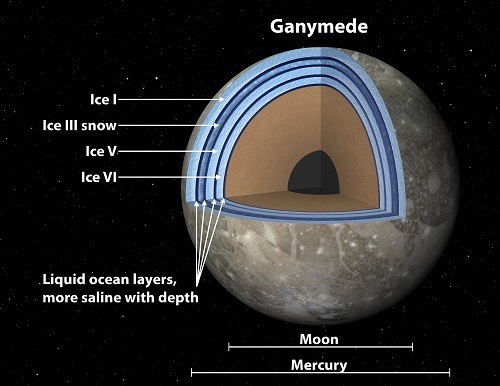
Image: This artist’s concept of Jupiter’s moon Ganymede, the largest moon in the solar system, illustrates the “club sandwich” model of its interior oceans. Scientists suspect Ganymede has a massive ocean under an icy crust. Previous models of the moon showed the moon’s ocean sandwiched between a top and bottom layer of ice. A new model, based on experiments in the laboratory that simulate salty seas, shows that the ocean and ice may be stacked up in multiple layers, more like a club sandwich. Credit: NASA/JPL.
Larger than Mercury, Ganymede may have 25 times the volume of water found on Earth. The JPL work, reported in a new paper in Planetary and Space Science, suggests that the sea bottom in the various layers may not be coated with ice but with salty water. Earlier models had shown the probability of dense ice at the bottom of a huge ocean with enormous pressures, but Vance’s team added salt to its models and found that liquid dense enough to sink to the sea floor was the result. Salt, as it turns out, makes the ocean denser, particularly under the extreme pressure conditions found within Ganymede and other moons.
Oceanic pressure on Ganymede would be high, for the moon’s oceans may be up to 800 kilometers deep. The deepest, densest form of ice thought to exist on Ganymede is known as Ice VI. If ordinary refrigerator ice (Ice I) floats in a glass of water, heavier forms of ice produced by extreme pressures show much more compact crystalline structure, with the molecules packed more tightly together, which is why some forms of ice can fall to the bottom of the ocean.
That would seem to produce an icy ocean floor, making potentially life-producing chemical interactions between water and rock unlikely. But the team’s models show up to three ice layers and a rocky seafloor, with the lightest ice on top and salty, dense liquid at the bottom. Moreover, the layers in the diagram above account for odd phenomena, with Ice III in the uppermost ocean layer being formed in the seawater and salts precipitating out. As the heavier salts begin to settle to the bottom, the lighter ice would float upward, perhaps melting again before it reaches the top of the ocean or leaving slush layers in the Ganymede ocean. When it’s snowing on (or within) Ganymede, in other words, the snow floats up, not down.
This JPL news release offers more, including the notion that the ‘club sandwich’ structure the researchers describe varies over time, sometimes returning to a single ocean found below a layer of Ice I and existing on top of regions of different high-pressure ices. In any case, the idea of chemical interactions where water and rock meet is intriguing from an astrobiological viewpoint, suggesting that a wet seafloor could produce the necessary conditions for life. The salts the Vance team added to its model can produce a sea bottom with the needed dense liquids.
The paper is Vance et al., “Ganymede׳s internal structure including thermodynamics of magnesium sulfate oceans in contact with ice,” Planetary and Space Science published online 12 April 2014 (abstract). Also of interest: Vance et al., “A Passive Probe for Subsurface Oceans and Liquid Water in Jupiter’s Icy Moons,” submitted to Icarus (preprint).






May 1, 2014
The Europa Imperative
Stanley G. Weinbaum is best known for the 1934 short story “A Martian Odyssey,” lionized by readers and critics alike after it appeared in the July issue of Wonder Stories. Isaac Asimov would later opine that “A Martian Odyssey” was one of a handful of stories that changed the way all later science fiction was written. But Weinbaum’s depiction of a genuinely alien being called Tweel sometimes obscures his other work, which you can find collected in The Best of Stanley G. Weinbaum (1974), a worthwhile addition to the library of any SF fan, and a reminder of the loss the genre suffered when the author died at age 33.

This morning I’ve been thinking back to a little known Weinbaum story called “Redemption Cairn,” which ran in the March, 1936 Astounding Stories and which, because I have a good run of Astounding issues from that era, sits not ten feet away from me on my shelf. I don’t know if this is the first appearance of Europa in science fiction, but “Redemption Cairn,” with its exotic biosphere in a valley on the moon, shows us a time when Jupiter was thought to produce enough heat to make the Galilean moons habitable. Arthur C. Clarke would imagine a warm Europa as well, but his, in 2061 Odyssey Three (1988) was the result of Jupiter’s transformation into a small star and the birth of a biosphere.
One thing we’re not going to find when we get a dedicated probe to Europa is a tropical habitat, but the musings of science fiction writers remind us that we shape our aspirations around our dreams, and the encounter with the unknown becomes just as meaningful in real life whether the ocean we’re probing lies under balmy skies or a kilometers-thick layer of ice. Want to see an icy, science fictional Europa? Try Kim Stanley Robinson’s Galileo’s Dream, in which the astronomer is transported from Padua into the depths of Europa’s deep ocean.
Image: Science fiction pioneer Stanley G. Weinbaum.
A NASA Request for Information
Galileo had plenty of Europan connections, from being the person who discovered the moon to having his name attached to the spacecraft that sent us our best images of the surface. Like all of us, NASA would like more information about Europa than the Galileo mission could provide, and while it takes science fiction to get us into the Europan ocean for now, down the road we may have more concrete options. The agency’s recent issuance of a Request for Information (RFI) asks the scientific and engineering communities to come up with ideas that can help us answer some of our longest-standing questions. The ultimate goal: A $1 billion mission (excluding launch) that can achieve the following goals, or at least as many of them as possible:
Characterize the extent of the ocean and its relation to the deeper interior
Characterize the ice shell and any subsurface water, including their heterogeneity, and the nature of surface-ice-ocean exchange
Determine global surface, compositions and chemistry, especially as related to habitability
Understand the formation of surface features, including sites of recent or current activity, identify and characterize candidate sites for future detailed exploration
Understand Europa’s space environment and interaction with the magnetosphere.
These requirements come from the National Research Council’s 2011 Planetary Science Decadal Survey. Why we need a mission like this is clear enough. For all its achievements, Voyager could give us nothing more than a quick flyby, and while the Galileo spacecraft was able to make repeated flybys (fewer than a dozen), it labored under serious communications problems with the failure of its high-gain antenna. We’ve seen what Cassini can do in the Saturn system with repeated observations of high-value targets like Titan and Enceladus, but Europa is a tough nut to crack, particularly given the radiation environment that surrounds Jupiter.
For more on the RFI, whose deadline is May 30, visit the NSPIRES site. NASA has been funding work into mission concepts and in particular the science instruments that will be needed for Europa, including possible ways to penetrate surface ice. The Decadal Survey considers a Europa mission among the highest priority scientific pursuits for the agency, and the recent findings from Hubble of possible water vapor ejections from the moon’s surface add punch to the statement. The RFI, says John Grunsfeld, associate administrator for the NASA Science Mission Directorate at the agency’s headquarters, “is an opportunity to hear from those creative teams that have ideas on how we can achieve the most science at minimum cost.”
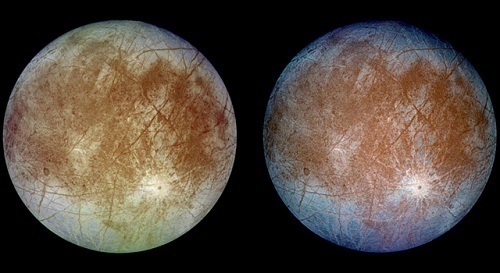
Image: Two views of the trailing hemisphere of Jupiter’s ice-covered satellite, Europa, returned by the Galileo spacecraft. The left image shows the approximate natural color appearance of Europa. The image on the right is a false-color composite version combining violet, green and infrared images to enhance color differences in the predominantly water-ice crust of Europa. Dark brown areas represent rocky material derived from the interior, implanted by impact, or from a combination of interior and exterior sources. Bright plains in the polar areas (top and bottom) are shown in tones of blue to distinguish possibly coarse-grained ice (dark blue) from fine-grained ice (light blue). Long, dark lines are fractures in the crust, some of which are more than 3,000 kilometers (1,850 miles) long. The bright feature containing a central dark spot in the lower third of the image is a young impact crater some 50 kilometers (31 miles) in diameter. This crater has been provisionally named “Pwyll” for the Celtic god of the underworld. Credit: NASA/JPL.
Through Galileo’s Lens
But back to science fiction, and Kim Stanley Robinson, a fine science fiction author indeed. In Galileo’s Dream, before the celestial voyaging that will give Galileo a much closer look at what he sees in his telescope, Robinson depicts the discovery of the Galilean moons:

On the night of January 12, Galileo trained the glass on Jupiter in the last moments of twilight. At first he could see again only two of the little bright stars, but an hour later, when it was fully dark, he checked again, and one more had become visible, very close to Jupiter’s eastern side.
He drew arrows trying to clarify to himself how they were moving, shifting his attention between the view through the glass and his sketches on the page. Suddenly it became clear, there in the reiterated sketches: the four stars were moving around Jupiter, orbiting it in the same way the moon orbited the Earth. He was seeing circular orbits edge-on; they lay nearly in a single plane, which was also very close to the plane of the ecliptic, in which the planets themselves moved.
He straightened up, blinking away the tears in his eyes that always came from looking too long, and that this time came also from the sudden urge of an emotion he couldn’t give a name to, a kind of joy that was also shot with fear. “Ah,” he said. A touch of the sacred, right on the back of his neck: God had tapped him. He was ringing.
Image: Portrait of Galileo by Ottavio Leoni (1578–1630).
The pace of space exploration is sometimes frustrating, particularly when we gauge it against the optimism of the Apollo era and the dreams of von Braun. But when I think about Europa and our opportunities there, I always think back to this passage in Robinson, and ultimately back to Galileo himself. We have come so far since the days when he identified those bright objects around Jupiter as moons. Surely the drive for discovery — the zest, the enchantment of it — that drove Galileo is something hard-wired into our species, a sort of ‘ringing,’ as Robinson describes it, or perhaps a kind of inner fire that won’t allow us to turn away from these explorations.






April 30, 2014
Night and Day on β Pictoris b
Writing yesterday about Kevin Luhman’s discovery of another cold brown dwarf in the stellar neighborhood reminded me of work we discussed earlier this year in which the weather on the surface of Luhman 16 B was mapped. This was done using the European Southern Observatory’s Very Large Telescope (see Focus on the Nearest Brown Dwarfs), which found variations in the brightness of one of the two dwarfs in this interesting binary just six light years from the Sun. We are beginning, in other words, to chart features in the atmosphere of a brown dwarf whose atmosphere is 1100 degrees Celsius and filled with molten iron and minerals.
With that in mind, the news that Dutch astronomers also using the Very Large Telescope (with the CRIRES spectrograph) had measured the rotation rate of an exoplanet immediately caught my eye. Beta Pictoris b orbits its primary some 63 light years from Earth in the constellation Pictor (The Painter’s Easel). It was one of the first exoplanets to be directly imaged and, at a distance of 8 AU, the closest exoplanet to its star that has ever been imaged. Now we learn that the equatorial rotation velocity of the planet is almost 100,000 kilometers per hour.
Bear in mind that Beta Pictoris b is about 3000 times more massive than the Earth and some sixteen times larger, yet a day on this world lasts a paltry eight hours. We can contrast that with Jupiter’s equator, whose cloud cover rotates at 47,000 kilometers per hour, or with the Earth, whose rotation rate is a comparatively puny 1674.4 kilometers per hour. What we’re seeing here is an extension of the relationship between mass and rotation that we’ve already observed in the Solar System. Remco de Kok is a co-author on the paper announcing the find:
“It is not known why some planets spin fast and others more slowly,” says de Kok, “but this first measurement of an exoplanet’s rotation shows that the trend seen in the Solar System, where the more massive planets spin faster, also holds true for exoplanets. This must be some universal consequence of the way planets form.”
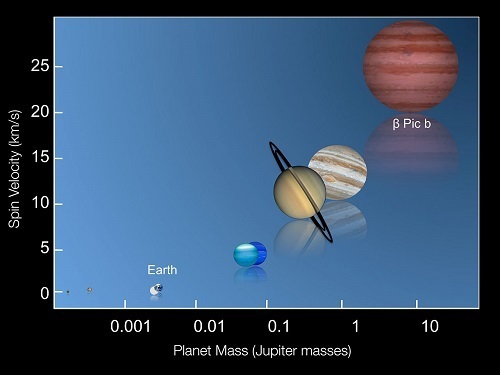
Image: This graphic shows the rotation speeds of several of the planets in the Solar System along with the recently measured spin rate of the planet Beta Pictoris b. Credit: ESO/I. Snellen (Leiden University).
That we could make such measurements of this young world (Beta Pictoris b is about 20 million years old) is an indication of advancing techniques similar to those that brought us the weather on Luhman 16B. The researchers, from Leiden University and the Netherlands Institute for Space Research (SRON), studied changes in the wavelength of received light to detect the different speeds and direction of different parts of the planet. This was exquisitely challenging work in that it involved separating this already tiny signal from the light of the parent star.
The team’s variation on Doppler imaging allowed measurements of the wavelengths of radiation from the planet to a precision of one part in 100,000, enough to detect the velocity of the various parts of the planet’s atmosphere that are emitting light. “Using this technique we find that different parts of the planet’s surface are moving towards or away from us at different speeds, which can only mean that the planet is rotating around its axis,” adds lead author Ignas Snellen.
We can imagine future work not only in creating a global map of Beta Pictoris b’s cloud patterns but, with the help of the upcoming European Extremely Large Telescope (E-ELT) and its planned METIS spectrograph and imager, maps of exoplanets much smaller in size. For now, though, Beta Pictoris b may remain the target of the team’s near-term studies. From the paper:
The SNR [signal-to-noise ratio] that can be achieved on a planet spectrum for this type of observation is a strong function of telescope diameter D. This opens the way of obtaining two-dimensional maps of the planet using Doppler imaging, a technique used to map spot distributions on fast-rotating active stars. Very recently, a first Doppler image map was produced for the nearby brown dwarf Luhman 16B (K=9.73) using CRIRES on the VLT, showing large-scale bright and dark features, indicative of patchy clouds. The planet β Pictoris b is only a factor 13 fainter than Luhman 16B. Our simulations…show that a similar study can be conducted on β Pictoris b using future instrumentation.
The paper is Snellen et al., “The fast spin-rotation of a young extra-solar planet,” to be published online in Nature 1 May 2014.






April 29, 2014
Luhman’s Latest: A New, Nearby Brown Dwarf
Kevin Luhman (Pennsylvania State University) has focused much of his research on the formation of low-mass stars and brown dwarfs in star-forming regions near the Sun. This involves working with relatively young stars, but Luhman is also on the alert for older objects, very cool brown dwarfs in the solar neighborhood. Brown dwarfs cool over time, and as Luhman describes on his university web page, they are ‘valuable laboratories for studying planetary atmospheres.’ They also give us a chance to test theories of planet formation in extreme environments.

Now we have Luhman’s latest, and it would not be a surprise if the whole category of nearby, cool stellar objects begins to get referred to as ‘Luhman objects’ or some such. Remember that it was just back in March that the astronomer discovered, using WISE images, a binary brown dwarf system at a scant 6.5 light years from Earth. The new find is WISE J085510.83-071442.5. It has the third highest proper motion and the fourth largest parallax of any known star or brown dwarf, and can lay claim to being, at least for a time, the coldest brown dwarf on record.
Image: Penn State’s Kevin Luhman, a specialist in low mass stars and brown dwarfs, who is filling in our map of such objects close to the Sun.
How cold? This object is thought to be between -48 to -13 degrees Celsius, colder than previous record holders, which were found to be close to room temperature. WISE imagery from 2010 was confirmed by two additional images taken by Spitzer in 2013 and 2014, with further observations at the Gemini South telescope on Cerro Pachon in Chile. The WISE and Spitzer data were used to measure the distance to the object via parallax. It turns out to be 7.2 light years away, fitting nicely into the chart below, which shows the Sun’s immediate neighborhood.
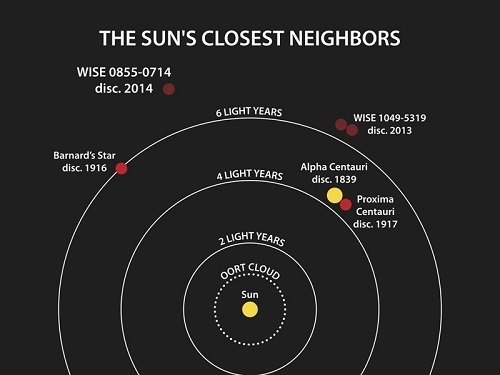
Image: This diagram illustrates the locations of the star systems closest to the sun. The year when the distance to each system was determined is listed after the system’s name. NASA’s Wide-field Infrared Survey Explorer, or WISE, found two of the four closest systems: the binary brown dwarf WISE 1049-5319 and the brown dwarf WISE J085510.83-071442.5. NASA’s Spitzer Space Telescope helped pin down the location of the latter object. The closest system to the sun is a trio of stars that consists of Alpha Centauri, a close companion to it and the more distant companion Proxima Centauri. Credit: NASA/Penn State University.
That’s a fascinating chart, and while all of us can share the determination to learn more about brown dwarf and planet formation and the atmospheres of cold objects, some of us also think in terms of targets for future probes, hoping that brown dwarf hunter Luhman may turn up something even closer than the three he has already discovered. Objects as cool as Luhman’s latest can all but disappear at visible wavelengths, but their infrared glow makes detection possible, with surely more to come. Thus Michael Werner, a Spitzer project scientist at JPL:
“It is remarkable that even after many decades of studying the sky, we still do not have a complete inventory of the sun’s nearest neighbors. This exciting new result demonstrates the power of exploring the universe using new tools, such as the infrared eyes of WISE and Spitzer.”
We’re talking about an object somewhere between 3 and 10 times the mass of Jupiter, which makes WISE J085510.83-071442.5 one of the least massive brown dwarfs known, if indeed it is a brown dwarf rather than a free-floating gas giant that has been expelled from some undetermined star system. Luhman comments on the latter possibility in the paper on this work:
At this mass, WISE 0855−0714 could be either a brown dwarf or a gas giant planet that was ejected from its system. The former seems more likely given that the frequency of planetary-mass brown dwarfs is non-negligible while the frequency of ejected planets is unknown. Assuming that WISE 0855−0714 is a Y dwarf, the four closest known systems now consist of two M dwarfs and one member of every other spectral type from G through Y.
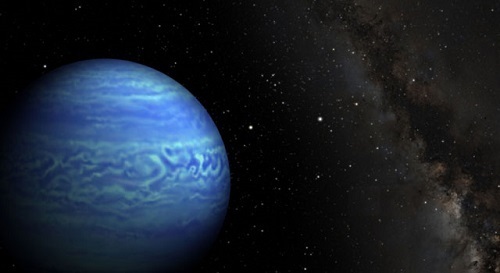
Image: This artist’s conception shows the object named WISE J085510.83-071442.5, the coldest known brown dwarf. Brown dwarfs are dim star-like bodies that lack the mass to burn nuclear fuel as stars do. WISE J085510.83-071442.5 is as cold as the North Pole (or between minus 48 to minus 13 degrees Celsius). The color of the brown dwarf in this image is arbitrary; it would have different colors when viewed in different wavelength ranges. Credit: NASA/JPL-Caltech/Penn State University.
The paper goes on to note that the newly discovered brown dwarf now offers the chance to test various atmospheric models in an unexplored temperature regime, something that will require refining the parallax measurement and ‘deeper near-IR photometry to better constrain its spectral energy distribution.’ We’ll also need to take advantage of near-term advances in our spectroscopy of the sort the James Webb Space Telescope should make available.
The paper is Luhman, “Discovery of a ~250 K Brown Dwarf at 2 pc from the Sun,” The Astrophysical Journal Letters Vol. 786, No. 2 (2014), L18 (abstract / preprint). A JPL news release is also available.






April 28, 2014
Interstellar Conferences for 2014
2014 isn’t nearly as top-heavy with interstellar conferences as the year before, but we do have two to discuss this morning, both of them slated for fall in North America. Looking through the preliminary information, I’m remembering how many good sessions grew out of last year’s meetings. For a field that grew up fueled largely by the enthusiasm of individuals who met in person only rarely, we suddenly found ourselves with the 100 Year Starship conference in Houston, Icarus Interstellar’s Starship Congress in Dallas, two Starship Century events (one in London, one in San Diego), the Tennessee Valley Interstellar Workshop (version 2) and a London conference on what Bob Parkinson so wonderfully calls ‘the philosophy of the starship.’
Various smaller get-togethers occurred as well, and so, of course, did huge space-dominated conferences like the International Astronautical Congress and other aeronautics, astronautics and SETI sessions around the world. But who would have thought even ten years ago, much less fifty, that we would be having multiple conferences in a single year arranged around starship topics, and that groups dedicated to studying the possibilities of interstellar flight would be proliferating? A friend and I were musing that we found ourselves living in a science fictional world, and the thought came that it just seemed that way because we were getting older. And, of course, we are, but it’s also true that deep space really has become a highly visible topic.
100 Year Starship Symposium 2014
The theme for this year’s 100 Year Starship Symposium is Pathway to the Stars, Footprints on Earth, a nod to the synergies the organization continues to seek out between the huge advances in technology and biological science we’ll need as we anticipate deep space missions and the developing spinoff tools we’ll gain from such work to improve life on Earth today. The symposium will be held at the George R. Brown Convention Center in Houston from 18 to 21 September.
Although registration for the actual event has not yet begun, the call for papers is now active, with abstract submissions manageable through the symposium site. The deadline for abstracts is May 31, with notification of acceptance on June 30. Accepted presentations and poster submissions are then due on the 10th of September. Quoting from the submission guidelines:
Submissions can be perspectives on the central dogma, experimental results, and review of a specific topic. You must ensure that it fits the track topic to which you are submitting. Individual presentations will only be presented in one track. Individuals do not have to be associated with an institution to submit an abstract. Please note that materials should be non-commercial in content, any commercial presentation that communicates a service, technology or product can be submitted to our poster session.
Submissions will be reviewed based on bona fide field of inquiry/thought/research that derive from validated patents, literature, mathematics or practice. The data submitted should represent one or more of the following:
Actual data or background search generated presents a challenge to current dogma or asks a significant question
Data moves the field forward or clarifies some aspect of the field
Solves a problem acknowledged in the field
Provides a novel, well supported integration and/or review of field and proposes specific concept
Submitted abstracts are well written, 300 word, concise and includes a statement of the following items. If actual data, results and conclusions are not available, please provide a well thought out plan for how the information will be generated.
Background
Problem and hypothesis
Experimental design (or literature review)
Data
Results
Conclusions and Discussion
The tracks are available on the symposium site. They range from propulsion and energy to near-term spinoff technologies, data, communications and information technology, and major issues of life support and sociology. The data and communication track is a new one, highlighting recent work on data retrieval and transmission at interstellar distances. Also new at the 2014 symposium will be a track on interstellar education, looking at the role of education at producing what the site calls ‘interstellar citizens’ and probing current and future educational practices. Poster presentations are available for discussions in a small group setting.
Tennessee Valley Interstellar Workshop
The third Tennessee Valley Interstellar Workshop will be held November 9-12 in Oak Ridge, Tennessee at the DoubleTree by Hilton Hotel with a theme of Long-Term Thinking–Present-Day Action. I’ve recently received the call for papers for this event, which was originally conceived by Les Johnson, Greg Matloff and Robert Kennedy in a wonderful hotel in the Italian alps in the town of Aosta. I remember the setting well, having spent several days there at one of the earlier Aosta conferences — it’s a place where long-term thinking seems to come naturally. Have a look at the TVIW website for further background, including Les’ summation of the event:
“The Tennessee Valley Interstellar Workshop is an opportunity for relaxed sharing of ideas in directions that will stimulate and encourage Interstellar exploration including propulsion, communications, and research. The ‘Workshop’ theme suggests that the direction should go beyond that of a ‘conference’. Attendees are encouraged to not only present intellectual concepts but to develop these concepts to suggest projects, collaboration, active research and mission planning. It should be a time for engaging discussions, thought-provoking ideas, and boundless optimism contemplating a future that may one day be within the reach of humanity.”
Presentation/paper and workshop topic submissions are now open through August 1, with the full papers and presentations due two weeks prior to the start of the meeting. Do note that this event is limited to 75 participants, with applications for attendance and further information about submissions made by email to tviw2014@tviw.us. A bit more from the call for papers:
Participants who do not wish to present a paper or facilitate a workshop will also be considered and are requested to submit a bio describing their involvement in the field of developing Interstellar concepts, including interstellar-related space science and technology and space advocacy. Submissions relating humanities, art and social sciences to interstellar exploration are also encouraged. Going to the stars will involve and engage most aspects of human society and innovation in all fields that may contribute are of interest. All Participants (including Presenters) are encouraged to bring a free-standing poster describing their Interstellar work, suitable for exhibition.
Presenters will be given thirty minutes to present their work including a Q&A session at the end, and it seems probable (though I haven’t confirmed this) that selected papers will be submitted to the Journal of the British Interplanetary Society for publication. Note, too, that on Sunday November 9, TVIW will conduct two seminars to which accepted attendees are invited, one a three-hour short course on space propulsion taught by Les Johnson, the other a course on terraforming, its methods and rationale, taught by Ken Roy. Registration for these seminars can be managed through the TVIW website once your attendance has been confirmed. Direct any questions about participation to registrar@tviw.us.





April 25, 2014
The Infrastructure Problem [1]
Nick Nielsen today tackles an issue we’ve often discussed in these pages, the space-based infrastructure many of us assume necessary for deep space exploration. But infrastructures grow in complexity in relation to the demands placed upon them, and a starship would, as Nick notes, be the most complex machine ever constructed by human hands. Are there infrastructure options, including building such vehicles on Earth, and what sort of societies would the choice among them eventually produce? You’ll find more of Nielsen’s writing in his blogs Grand Strategy: The View from Oregon and Grand Strategy Annex. In addition to his continuing work for the space community, Nick is a contributing analyst with strategic consulting firm Wikistrat.
by J. N. Nielsen

Although we have spacecraft in orbit around Earth, as well as on the moon and other planets and their moons, and even spacecraft now in interstellar space, so that the products of human industry are to be found throughout our solar system and beyond, we have as yet no industrial infrastructure off the surface of the Earth, and this is important. I will try to explain how and why this is important, and why it will remain important, potentially shaping the structure of our civilization.
Made on Earth
All our spacecraft to date have been built on Earth where we possess an industrial infrastructure that makes this possible. The International Space Station, of course, was assembled in orbit from components built on the surface of the Earth and boosted into space on rockets. It has long been assumed, if we were to build a very large spacecraft (say, for a journey to Mars or beyond), that it would be constructed in much the same way: the components would be engineered on Earth and assembled in space. There is an obvious terrestrial analogy for this: we build our ships on land, where it is convenient to do the work, and then launch them only when the hull is seaworthy. Once the hull is in the water it is fitted out, and then come sea trials, but it would not be worth the trouble to try to build the hull of a ship in the water.
The analogy, however, seems misleading when applied to space. In space, we could build very large spacecraft in microgravity environments that would considerably ease the task of manipulating awkwardly large and heavy components. Also, large spacecraft never intended to enter into planetary atmospheres could be built in the vacuum of space with no concern for the aerodynamics that are crucial for a craft operating in a planetary atmosphere. The stresses of transiting a planetary atmosphere would be an unnecessary requirement for most deep-space vehicles. But what would it take to really build a spacecraft in space, in contradistinction to the assembly of completed modules in orbit?
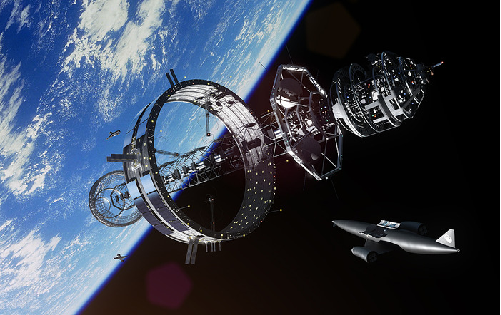
Image: One take on building starships in space. This view of the Project Icarus orbital construction ring prototype design shows resupply from the Skylon single stage to orbit spacecraft now under development by Reaction Engines. Credit: Adrian Mann.
Even a “basic machine shop” in orbit would not come close to providing the kind of industrial infrastructure we have been building on the surface of the Earth for more than two hundred years now. Production processes ripple outward until they involve much of the planet’s industrial production capacity, a lesson that can be illustrated by Adam Smith’s famous example of the day-laborer’s woolen coat or by what Austrian economist Eugen Böhm von Bawerk called round-about production processes. [2] I suspect that many will argue that the advent of 3D printing is going to change everything, and that all you need to do is to boost a 3D printer into orbit and then you can produce anything that you might need in orbit. Well, not quite.
The Growth of Infrastructure
As civilization grows more complex, infrastructure becomes more complex, and more precursors are necessary to achieving the basic functionality assumed by the institutions of society. We see this in the increasing complexity of our cities. There was a time when cutting edge technology meant bringing water into a city with aqueducts and having underground sewers to carry away the waste. To the infrastructure of water supplies we have added fossil fuel supplies, electricity supplies, telecommunications lines, and now fiber optic cables for high speed internet access. (On the growing infrastructure of civilization cf. my post The Computational Infrastructure of Civilization.) All of these infrastructure requirements have been continually updated since their initial installation, so that, for example, the electricity grid is significantly more advanced today than when introduced.
For the lifeway of nomadic foragers, no infrastructure is necessary except for a knowledge of edible plants and available game. Since the geographical expansion of nomadic foragers is slow, change in requisite knowledge is also slow, as a moving band of foragers only very gradually sees the diminution of traditional dietary staples and only very gradually sees the emergence of unfamiliar plants and animals. Much greater infrastructure characterizes agrarian-ecclesiastical civilization, and much greater still industrial-technological civilization. The extraterrestrialization of industrial-technological civilization (yielding extraterrestrial-technological civilization) requires an order of magnitude of increase in infrastructure for the necessary maintenance of human life.
How to Build a Starship
The spacecraft requisite to the achievement of extraterrestrialization are today, and are likely to remain, the most complex and sophisticated machines ever built by human beings. To produce not only their components, but the machines required to produce the components, requires the entire advanced infrastructure that we now possess in our most developed centers of manufacturing. A useful analogy for understanding the industrial requirements for the production of spacecraft is to think of building the spacecraft of the future as we think today of building a nuclear-powered submarine. Like a nuclear submarine, an SSTO (single stage to orbit) spacecraft will be one of the most technically difficult and demanding engineering tasks ever attempted; it will involve parts suppliers from all over the world; it will involve millions of individual parts that each have to fitted in place by a human hand, and the assembly itself is likely to require many years of painstaking construction.
There is another sense in which spacecraft probably will be like nuclear submarines: a spacecraft is going to have significant power demands, and the most compact way to address this with our current technology is what we now do with your biggest submarines: nuclear power. The compact reactors on submarines (and aircraft carriers, which typically have two reactors for redundancy) have proved themselves to be safe and serviceable, and they can keep generating power for 25-30 years without refueling – possibly a sufficient period of time to make an interstellar journey. We can, of course, readily make use of solar power in space, though this is not compact and would not be suitable for a starship, which would be operating for extended periods of time far from the light of the sun or any other star.
I think it is clear that once we attain the ability to produce technologies commensurate to the challenge of a practicable starship, we are likely going to want to employ more than one propulsion technology, so that the drive system is highly hybridized. By “hybridized” I mean two or more forms of propulsion on a single spacecraft, and if these multiple forms of propulsion can share structures of the propulsion system, the more they do so the more truly “hybrid” the propulsion design. We may want to have one drive system for use in planetary atmospheres, another for orbital maneuvering, a third for interplanetary travel, and lastly a drive for interstellar travel. Later that list may need to be lengthened for a drive for intergalactic travel.
Hybrid propulsion systems are already in development, and these innovations could greatly improve the efficiency of chemical rockets. I have written many times about the Skylon spaceplane with its “combined cycle” SABRE engines that operate as conventional jet engines in the atmosphere, and which are able to transition to rocket propulsion for exoatmospheric operation. (Cf., e.g., Skylon spaceplane engine concept achieves key milestone, Key Tests for Skylon Spaceplane Project, Move to Open Sky for Skylon Spaceplace, and Addendum on Jet Propulsion Technology) This is a truly hybrid propulsion system, as the jet engine and chemical rocket share structures of the propulsion system, though it remains within the parameters of chemical rockets.
For faster travel to farther destinations, we will need hybrid propulsion systems of exotic technologies that do not exist today except in theory. A spacecraft with an Alcubierre drive and some basic form of chemical or nuclear or ion thrusters might be able to do the job, and this might well be the first step in building a starship that give us access to the galaxy in the way that we now have access to the surface of Earth. However, a spacecraft with an Alcubierre drive and a fusion or antimatter drive, or with Q-thrusters, would be much better. If, for example, you traveled to our closest cosmic neighbor, Alpha Centauri, you might want to travel the greater part of the distance with the Alcubierre drive, but once you get there you would probably want to make your passage between Proxima Centauri, Alpha Centauri A, and Alpha Centauri B with your fusion or antimatter drive, and you would definitely want to explore the planets of these stars with this “slower” drive. (And you probably wouldn’t want to use something like a Bussard ramjet for transit within a solar system.)
Two Responses to the Infrastructure Problem
A spacecraft mounting the kind of hybridized propulsion systems outlined above would represent an order of magnitude complexity even beyond the example of assembling a nuclear submarine. For the next few decades at least, and perhaps for longer, there will be no machine tools and no industrial plant in space. All the facilities we need to build a large and complex engineering project that is likely to occupy many years of painstaking effort, are earth-bound. Moreover, such technical assembly work would probably need to be performed by skilled craftsmen in a familiar environment conducive to careful and patient work. While there are significant advantages to constructing spacecraft in orbit, as noted above, the world’s most advanced industrial plant and best construction teams are on the earth and will be for some time, so that there remain compelling reasons for continuing to construct spacecraft on Earth, despite being at the bottom of a gravity well. This, in a nutshell, is the infrastructure problem.
There are two obvious responses to the infrastructure problem: (1) we accept the limitations of our industrial plant at face value and organize all space construction efforts around the assumption that spacecraft will be built on Earth, or (2) we begin the long task of constructing an industrial infrastructure off the surface of Earth. This latter approach may take as long as or longer than the building of our industrial infrastructure on Earth. While we have the advantage of higher technology and knowing what it is we want to produce, we also face the disadvantage of the harsh environment of space, and the need to initially boost from the surface of Earth everything not only required for industry, but also everything required for human life.
Almost certainly any human future in space will consist of some compromise between these two approaches, with the compromise tending either toward Earth-based industry or space-based industry. The model of extraterrestrialization that eventually prevails will not only be a matter of socioeconomic choice, but also a function of what is technological possible and what is technologically practicable. This latter requirement is insufficiently appreciated.
The Role of Contingency
The large-scale structure of human civilization, once it expands into space (provided we do not languish in permanent stagnation) will depend upon technological innovations that have not yet happened, and therefore the parameters of which are not yet known. That is to say, humanity as a spacefaring civilization is not indifferent to how we are able to travel in space, and how we are able to travel in space will be a result of the sciences we develop, the technologies that emerge from this science, and which among these technologies prove to be something that can be engineered into a practical vehicle, in terms of extraterrestrial transportation.
Just as we as a species are subject to contingencies related to the climatological conditions that shaped our evolution, the geography that has shaped our civilization, the gravity well of the Earth as a function of its mass that constrained our initial entry into space, and eventually the layout of our solar system as it will shape the initial spacefaring civilization that we can build in the vicinity of our own star, so too we are subject to contingencies that will arise out of our own actions (and inactions). These latter contingencies include the sciences we pursue, the technologies we develop, and the engineering of which we are capable. The human contingencies that determine the structure of our civilization in the future also include unknowns such as exactly which science, technology, and engineering projects get funding (cf. my recent post Why the Future Doesn’t Get Funded).
If it turns out that the science behind the Alcubierre drive concept is sound, and that this science can be the basis of a technology, and this technology can be engineered into a practicable starship, we may never construct an industrial infrastructure in space. It may prove to be easier to construct starships not as massive works slowly assembled in Earth orbit, but rather as relatively compact spacecraft constructed in the convenience of a hangar, which, once finished, can be rolled out onto the tarmac, fired up, and blasted into space, thence to activate its Alcubierre drive once in orbit in order to fly off to other worlds. If, in addition, habitable planets (or planets that can be made habitable) are not too rare in the Milky Way, and human beings prefer to spend their time planetside, the industrialization of space may never occur. In this scenario, space-based industry always remains marginal, even as we become a spacefaring civilization.
As it is, we already today seeing the beginnings of the gradual transition of our industrial infrastructure into something cleaner than the smoke-belching chimneys of the early industrial revolution. As this process continues, and we continue to improve the efficiency of solar cells, there may be little or no economic benefit for moving industry into space. We may pass a threshold, beyond which Earth-based industry can be made entirely benign, therefore obviating the need to move industry into space. But all of this hinges on unknowns of an eminently practical sort, and which we cannot predict until we have actual experience operating the technologies in question.
Space-Based Infrastructure and Planetary-Based Infrastructure
If the Alcubierre drive turns out to be impracticable, or even not practicable at technological levels of development obtainable in the next few hundred years, then the need to construct different kinds of spacecraft will be more pressing. The idea of building a sleek spacecraft in a hangar and blasting off to other worlds directly from Earth’s surface may be impossible. In this case, becoming a spacefaring species, and especially becoming a starfaring species, will likely mean the construction of enormous industrial works off the surface of the Earth, initially assembling large spacecraft in Earth orbit or beyond, but gradually providing more and more goods and services in space without having to boost them all from the ground, which means the industrialization of space.
The industrialization of space, in turn, would mean a very different kind of large-scale spacefaring civilization than a spacefaring civilization that had no need of the industrialization of space, as described in the examples above. A spacefaring civilization of primarily space-based industry would be distinct from a spacefaring civilization of primarily planetary-based industry. Distinct social, political, and economic institutions and imperatives would emerge from these distinct industrial infrastructures.
If, as Marx claimed, ideological superstructures follow from the economic infrastructure that the former emerge to justify, [3] then it is to be expected that space-based economic infrastructure will produce an ideological superstructure distinct from planetary-based economic infrastructure. In the distant future, when we have occasion to survey many different spacefaring civilizations, this may prove to be a fundamental distinction that divides them.
Notes
[1] At the Icarus Interstellar Starship Congress last year, a member of the audience asked a question of Kelvin Long in which the questioner used the phrase, “the infrastructure problem,” which strikes me as the perfect formulation for the topics I am covering today.
[2] On Adam Smith’s example of the day-laborer’s woolen coat cf. Smith’s The Wealth of Nations, the final paragraph of Book I, chapter 1; on round-about production processes in the work of Eugen Böhm von Bawerk, cf. Thesis 22 of my book Political Economy of Globalization.
[3] The locus classicus for this Marxian view is to be found in Marx’s A Contribution to The Critique of Political Economy, translated from the Second German Edition by N. I. Stone, Chicago: Charles H. Kerr & Company, 1911, Author’s Preface, pp. 11-12: “In the social production which men carry on they enter into definite relations that are indispensable and independent of their will, these relations of production correspond to a definite stage of development of their material powers of production. The sum total of these relations of production constitutes the economic structure of society — the real foundation, on which rise legal and political superstructures and to which correspond definite forms of social consciousness. The mode of production in material life determines the general character of social, political, and spiritual processes of life. It is not the consciousness of men that determines their existence, but, on the contrary, their social existence determines their consciousness.” Note that Marx usually refers to the “economic base” of a society rather than to its “economic infrastructure.”






Paul Gilster's Blog
- Paul Gilster's profile
- 7 followers






